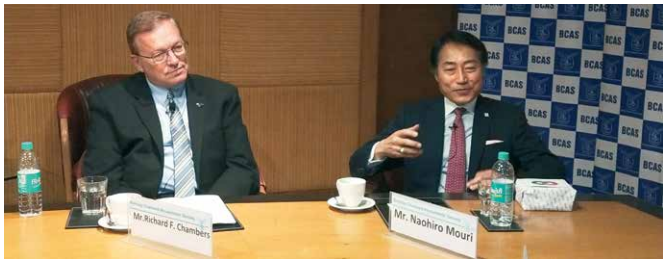53. Smt. Sarabjit Kaur vs. ITO
[2022] 96 ITR(T) 440 (Chandigarh – Trib.)
ITA Nos.:1144 & 1145 (Chd.) of 2019
A.Ys.: 2011-12 and 2013-14
Date of order: 30th March, 2022
Sections: 69, 69A
Where the assessee stated that the source of cash deposit in its bank accounts was the balance of cash in hand brought forward from earlier assessment years, but the AO treated the same as an unexplained investment without assigning any reason, then impugned additions made u/s 69 was not justified.
Where the Department had accepted that the assessee had earned a tuition fee in preceding assessment years then in terms of principle of consistency, the AO had no justifiable reason to disbelieve assessee’s claim of having received income from tuition fee and add the same to assessee’s income as unexplained money u/s 69A.
FACTS
A.Y. 2011-12
The assessee earned income from tuition as well as rent, and interest from bank and other parties. An information was received from the Investigation Wing of the Income Tax Department vide letter dated15th March, 2017 that the assessee had deposited cash of Rs. 8,00,000 in her bank account maintained with Axis Bank, Jagraon and Rs. 5,40,000 in her bank account with HDFC bank, thus, totalling to a deposit of Rs. 13,40,000. In view of this information, a notice u/s 148 of the Income-tax Act, 1961 was issued and in response to the said notice, the assessee filed the return which was originally filed u/s 139(1).
During the course of re-assessment proceedings, the assessee was required to explain the source of cash deposit of Rs. 13,40,000. The assessee stated before the AO that the deposit was from the closing balance of cashin hand in the immediately preceding assessment year amounting to Rs. 12,61,473 and was also partly out of cash withdrawals of Rs. 3 lakhs from Axis bank. The assessee was asked to furnish cash book/cash flow statement but the same were not furnished. The AO gave benefit of cash withdrawal of Rs. 3 lakhs from the Axis Bank and counted such withdrawal towards availability of cash for the purpose of cash deposit but proceeded to treat the remaining amount of Rs. 10,40,000 as unexplained and added the same to the income of the assessee u/s 69. The AO also proceeded to add the tuition fee of Rs. 2,03,600 as income from undisclosed sources. The assessment was completed at an income of Rs. 12,84,780.
Against the order of the learned AO, the assessee preferred first appeal before the CIT(A) who confirmed the action of the AO. Aggrieved by the order of CIT(A), the assessee filed a further appeal before the ITAT.
A.Y. 2013-14
The assessee had deposited cash of Rs. 10,40,000 in her bank account maintained with HDFC Bank, Jagraon.
Acting on the information received from the Investigation Wing vide letter 15th March, 2017, the assessee’s case was reopened by issuing notice u/s 148 of the Act. In response to the notice, the assessee filed the return which was originally filed u/s 139(1). The assessee was asked to explain the cash deposit in the bank account and the response of the assessee was that the amount was deposited from the brought forward cash balance of the immediately preceding assessment year i.e. year ending 31st March, 2012 amounting to Rs. 12,58,949. However, the assessee could not produce any books of account or cash flow statement in support of her claim. The re-assessment was completed by treating the cash deposit of Rs. 10,40,000 as unexplained income u/s 69 and tuition income of Rs. 2,03,600 as unexplained income u/s 69A of the Act.
Against the order of the ld. assessing officer, the assessee preferred first appeal before the CIT(A) who confirmed the action of the AO. Aggrieved by the order of CIT(A), the assessee filed further appeal before the ITAT.
HELD
The assessee submitted that he had regularly filed the balance sheet/statement of affairs for every assessment year along with the income and expenditure account. The assessee also submitted that in the assessment order passed u/s 143(3) r.w.s. 147 for A.Y.2010-11, the return of income was accepted and so was the cash deposit.
The assessee also contended that even the tuition income had been accepted in earlier assessment years as well as in subsequent assessment years and, therefore, there was no reason for not having accepted the tuition income for A.Y. 2011-12 and having treated it as income from unexplained sources. The Tribunal’s attention was also drawn to the assessment order passed u/s 143(3) r.w.s 147 for A.Y. 2012-13, wherein also the returned income of the assessee was accepted, which included cash deposits as well as tuition income. It was submitted that the availability of opening cash in hand had been duly justified by filing of balance sheet for the immediately preceding assessment year which had already been accepted by the Department and, therefore, there was no reason to not accept the same for the purpose of making cash deposit in A.Y. 2011-12.
Reliance was placed on the decision of ITAT Camp Bench at Jalandhar in Holy Faith International (P.) Ltd. vs. Dy. CIT [IT Appeal No. 181 (Asr) of 2017, dated 15th January, 2019] to contend that completed assessment cannot be reopened u/s 148 by simply acting upon the information received from the Investigation Wing and without application of mind by the AO.
It was observed by the Tribunal that if the assessee’s explanation of having the opening cash in hand was to be disbelieved, there should have been cogent reasoning behind the same. Since the Department had no cogent reasoning behind the disbelief, the Tribunal accepted the assessee’s contention that as on 31st March, 2010 the assessee had a closing balance of cash in hand of Rs. 12,61,473 which ought to have been considered for the purposes of explaining the source of cash deposits in the bank accounts.
The Tribunal by concurring with the view of the assessee, opined that the lower authorities had no reason to disbelieve the assessee’s claim of having earned tuition income during the years under consideration in light of the rule of consistency which was enshrined in the decision of the Apex Court in the case of Radhasoami Satsang vs. CIT [1992] 60 Taxman 248/193 ITR 321.
Accordingly, the appeals of the assessee for both the years under consideration were partly allowed.









